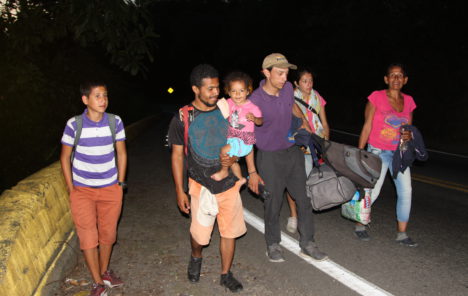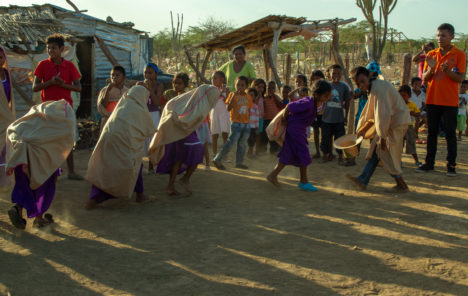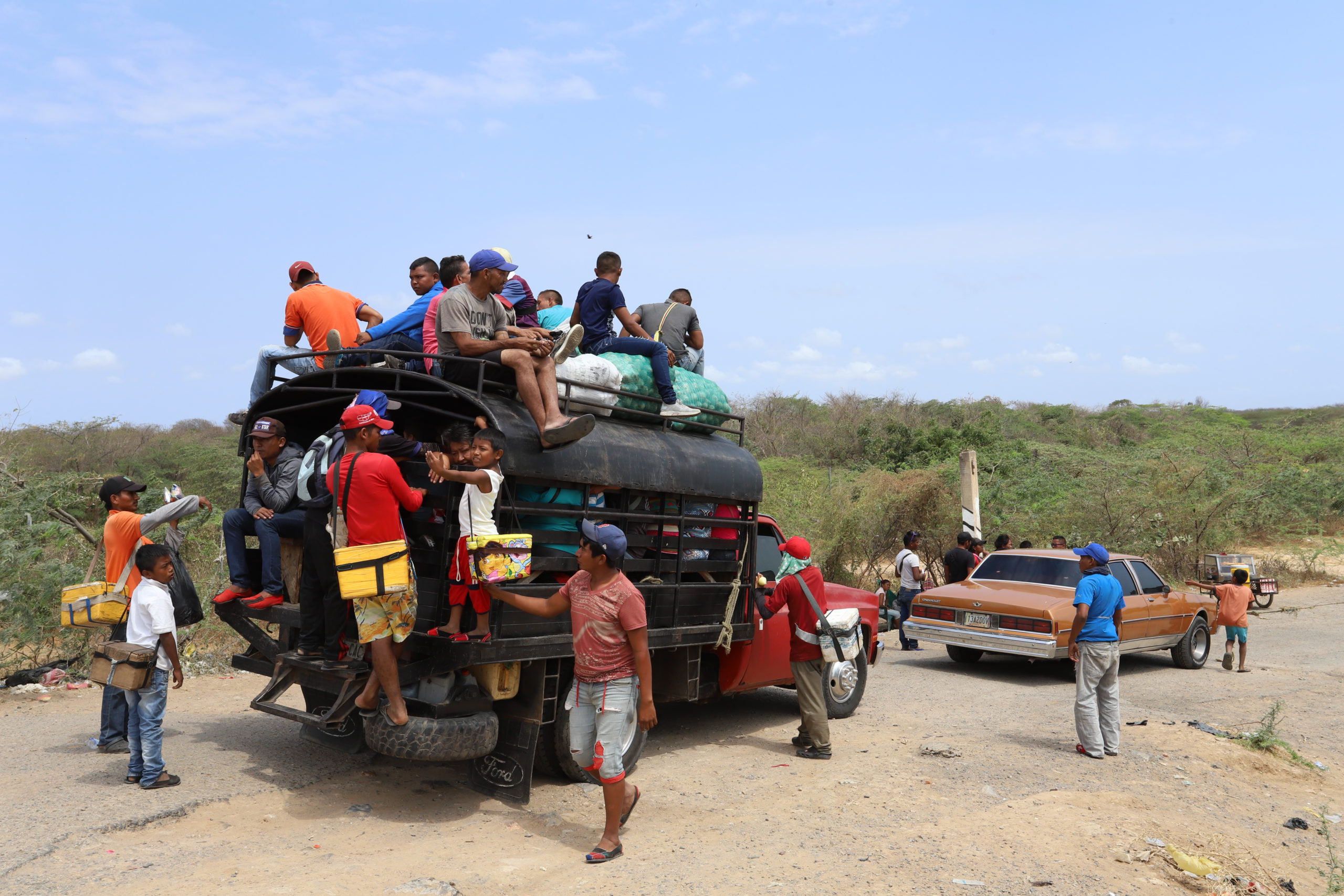The refugee crisis across Latin America, caused by the massive flow of people fleeing Venezuela, has worsened over the last two years and now stands as the largest displacement crisis to date in Latin America.
For almost a decade, Venezuela has been engulfed in a political and economic crisis. Inflation has skyrocketed and shortages of basic goods are widespread. Extreme poverty is insurmountably high for many. Meanwhile, anti-government protests and political instability has led to a volatile situation in the country.
As a result, millions have been braving a treacherous journey, including traversing the dangerous Darién Gap (an expanse of jungle between Colombia and Panama) to find safety and the hope of security outside their home country.
Official sources estimate over 7 million people have fled Venezuela.
And of this 7 million, 39% are being hosted in Colombia alone, where rapidly expanding populations, caused by the Venezuelan displacement, are leading to a shortage of housing, food and critical resources across Colombia.
Meanwhile, Brazil is also seeing an unprecedented influx of refugees from Venezuela. The United Nations High Commissioner for Refugees (UNHCR) anticipates this will rise to 6.5 million in 2024.
This, in turn, is creating an urgent need for humanitarian aid and support for host countries and their rapidly rising refugee population.
As is sadly often the case, children caught up in the crisis are being hit hardest.
Children are facing a multitude of risks to their safety, security, and education, including: sexual violence, family separation, child recruitment, and psychological difficulties.
"You never imagine your life and your family's life can change so much in the blink of an eye. One day you’re calm at home with a stable job, and the next you’re in another country without knowing anyone, looking for how to survive."
The impact of the Venezuelan crisis on children and families
Even despite relocation, families with children are facing high protection risks and live in precarious conditions.
It’s projected that by the end of this year, there will be 4.71 million Venezuelan people in-need of assistance* according to the updated Regional Refugee and Migrant Response Plan 2024 (RMRP 2024).
*(A ‘person in need’ is a person whose requirements for basic needs, special needs and employment services exceed the income, assets and other resources available to that person.)
- 92% lack resources for their journey
- 69% struggle to access clean drinking water
- Children aged 0 to 5 face gaps in nutritional interventions, daycare, and schools, and are exposed to risks.
The RMRP 2024
Settling into uncertainty
For children and families who have settled into Colombia and Brazil, prospects are scarcely better, as they face challenges to socio-economic integration and even access to basic services and rights.
Even despite the Temporary Protection Status (TPS) programme in Colombia, effective access to goods, services, and rights remains difficult.
In La Guajira and Santander, two of the most affected regions, informal settlements don’t have proper living conditions, with 82% living in inadequate conditions, and almost one fifth of the population are unemployed and over half earn less than minimum wage.
Protection risks are threatening the safety and security of children, families and communities.
- 51% eat twice a day or less
- 92% have insufficient water access
- 48% of children attend school
The RMRP 2024
Overpopulation is also creating precarious living conditions in Manaus, Brazil. Most families In Brazil rely on government aid, charity, and begging, leaving them vulnerable to exploitation and abuse. Inadequate healthcare and education infrastructure exacerbate their hardship, with refugees overwhelming already-strained public services.
Despite relocation efforts, approximately 40,000 refugees remain in Manaus, a third of which are single women with children. This represents a significant portion of the city’s ~2 million population.


The impact of armed conflict and organised crime on refugees
In Brazil, street-affected families, especially women and children, are at risk of physical, psychological and sexual abuse, as well as substance misuse, in a city grappling with drug-related crime. All these issues further compound the vulnerabilities of Venezuelan refugees, particularly young children.
Colombia, where most refugees have settled, is additionally affected by armed conflict. There’s a strong presence of armed individuals and organised crime groups, which have control over the territory and the illegal businesses that often target vulnerable migrant groups.
Children are the most vulnerable to protection risks during crises such as this, due in part to the prevalence of these organised crime groups. Risks include:
- Family separation: UNICEF Panamá recently identified 17 unaccompanied children on the border.
- Sexual violence: The presence of armed individuals across the region exposes children, especially girls and adolescents, to be sexually attacked.
- Child recruitment: Due to the active presence of armed individuals.
- Psychological impact: Grief and the conditions in the area affect psychological wellbeing and mental health, and if this is not properly addressed can affect child development, both in the immediate and long term.
- Educational lag: The situation undermines the possibility to continue their learning process and their right to education.
Luz Dary’s story: Robbed between Peru and Ecuador, Luz Dary and her family lost essential documents and all their money. Amidst complex circumstances and relying on the kindness of others for food and lodging, in her story, Luz Dary vividly recalls the hardships, including her daughter's prolonged illness due to poor food quality.
Furthermore, there is a hotspot in Colombia, near the border with Panama, Tapón del Darien (Darien jungle), where an unprecedented acute humanitarian crisis is taking place that poses huge risks to the safety and wellbeing of children of all ages.
The Darién jungle: a dangerous dead zone
The Darién jungle, a dense and swampy area on the border of Central America (Panama) and South America (Colombia), has served as a natural barrier to road communication between the two subcontinents. In recent years, it’s become the path for refugees and migrants aiming to reach North America.
Covering 5,000 square kilometres, the Darien Jungle is made up of tropical forests, steep mountains, and rivers. According to the United Nations High Commissioner for Refugees (UNHCR), the journey can last 10 days or more and is typically undertaken on foot or using unsafe transport, such as wooden boats.
During the crossing, migrants and refugees are exposed to multiple human rights violations and abuses, including sexual violence – “a particular risk for children, women, LGBTI people and people with disabilities”, said Marta Hurtado, spokesperson for the Office of the United Nations High Commissioner for Human Rights (OHCHR).
They’re also at risk of murder, disappearance, trafficking, robbery, and intimidation by organised crime groups.
According to National Migration Service of Panama, more than 400,000 migrants crossed the Darien jungle from January-August 2023, a significant increase on 2022 (248,000 recorded entries).
More than 40,000 children crossed the Darien at the beginning of 2023, of which nearly half were under 5 years old.
It’s estimated that, from these numbers, 65% are Venezuelan migrants.
Want to read more?
Find out how SOS Children’s Villages is supporting Venezuelan refugees in Colombia and Brazil here.
Read the real-life experiences of those affected by the crisis:

